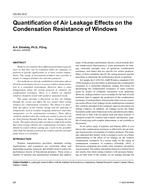Description
Windows are rated for their different performance parameters so that they can be evaluated either for adequacy to perform in specific applications or to meet certain requirements. The rating of fenestration products also provides a means to compare products for selection purposes.
Test methods are already established to determine almost all of the performance factors to assess window characterization in a controlled environment. However, there is some disagreement about the testing protocol of windows for condensation resistance. There is a debate on whether windows should be tested with sealed or unsealed cracks.
This paper provides a discussion on how air leakage through the cracks can affect the test results when testing windows for condensation resistance. The intent is to determine the effects of the window design and the selection of components, such as weather stripping, hardware, and other components, on its condensation resistance. These effects would be masked when the cracks are sealed to prevent cold air from flowing through them and, hence, changing the test results. This paper also provides test data to confirm the notion that when testing windows for condensation resistance, they should be tested without sealing any cracks in the assembly other than the interface between the window and the surround panel where it is installed.
Units: SI
Citation: Symposium, ASHRAE Transactions, vol. 109, pt. 1
Product Details
- Published:
- 2003
- Number of Pages:
- 7
- File Size:
- 1 file , 200 KB
- Product Code(s):
- D-16832




